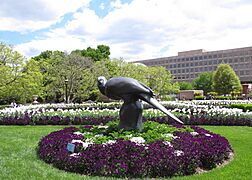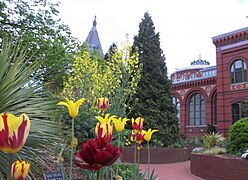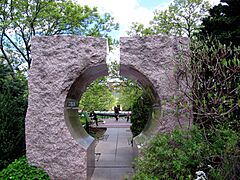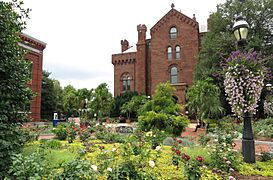Smithsonian Gardens facts for kids

A beautiful flower pattern in the Enid A. Haupt Garden.
|
|
| Established | 1972 |
|---|---|
| Location | The National Mall, Washington, D.C. |
| Type | Public gardens and archives |
| Public transit access | L'Enfant Plaza Metro Stop or Smithsonian Metro Stop (Washington Metro) |
The Smithsonian Gardens is like a living outdoor museum that is part of the famous Smithsonian Institution in Washington, D.C. It takes care of all the beautiful gardens, indoor plants, and plant exhibits you can see around the Smithsonian museums.
These gardens are not just for looks; they are learning spaces. The Smithsonian Gardens manages 180 acres of gardens on the National Mall. It also has a huge greenhouse and a special collection of old photos and records called the Archives of American Gardens. This archive helps us learn about the history of gardens in America.
Contents
How the Gardens Began
In 1972, the head of the Smithsonian, S. Dillon Ripley, had a great idea. He wanted to use the outdoor spaces around the museums for education and research. He started an Office of Horticulture, which is the science of growing plants, and hired the Smithsonian's first plant expert, James R. Buckler.
At that time, gardening was becoming very popular in the United States. This helped the new gardens become a big success with the public.
One of the first big projects was creating a Victorian-style garden for the 200th birthday of the United States in 1976. It was so popular that its design later inspired the main garden in the Enid A. Haupt Garden.
In 2009, the name was officially changed from the Horticulture Services Division to the Smithsonian Gardens.
Explore the Gardens
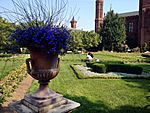
The Smithsonian Gardens includes many different and unique gardens. Most of them are located right on the National Mall near the museums. You can visit:
- Common Ground: Our American Garden: Located next to the National Museum of American History.
- Enid A. Haupt Garden: A beautiful rooftop garden located between the Smithsonian Castle and Independence Avenue.
- Freer Gallery of Art Courtyard Garden: A peaceful garden inside the courtyard of the Freer Gallery.
- Hirshhorn Museum and Sculpture Garden: A unique garden that combines art with nature.
- Kathrine Dulin Folger Rose Garden: A lovely garden full of roses, located next to the Castle.
- Mary Livingston Ripley Garden: A quiet and shady garden with winding paths.
- National Air and Space Museum landscape: The grounds surrounding the popular museum.
- Native landscape: A garden at the National Museum of the American Indian that features plants native to the Americas.
- Pollinator Garden: A garden designed to attract bees, butterflies, and other pollinators. It's located next to the National Museum of Natural History.
- Robert and Arlene Kogod Courtyard: An indoor courtyard with large trees inside the Reynolds Center for American Art and Portraiture.
- Urban Bird Habitat: A garden designed to be a safe home for birds in the city.
- Victory Garden: A garden that shows how people grew their own food during wartime, located at the National Museum of American History.
Keeping the Gardens Healthy
The Smithsonian Gardens uses a method called integrated pest management. This is a smart way to control pests like harmful insects. It uses methods that are safe for people, plants, and the environment.
Where Do the Plants Come From?
Many of the plants for the gardens and exhibits are grown in a special facility in Suitland, Maryland. This building has large greenhouses where thousands of plants are cared for.
One greenhouse is just for growing nectar plants. These plants provide food for the butterflies in the Butterfly Pavilion at the National Museum of Natural History.
Special Collections
Besides the living gardens, the Smithsonian Gardens also looks after important collections.
The Orchid Collection
This collection started with only five orchid plants in 1974. Today, it has over 8,000 orchids! People and organizations give orchids to the Smithsonian to keep them safe. Many of these beautiful flowers are displayed inside the museums.
Archives of American Gardens
This is a huge collection of photos and records about American gardens. It has information on over 6,300 gardens, some dating back to the 1870s. It's a great resource for students and historians who want to learn about garden design.
Garden Furniture and Tools
This collection includes old garden furniture like benches, fountains, and flower pots. These items show how garden styles have changed over time. You can see some of these historic pieces on display in the gardens.
Gallery
See also


